Best Fly Line
Skip To Save Time
The Fine Line of the Fly Line - Best Fly Line Available
When it comes to fishing, one of the most confusing aspects is the fly line taper. Yet it is one of the most simple aspects of game fishing. In this article, we look at the fly line taper, what it is, the differences between the options available and what are the best options on the market that you can buy.
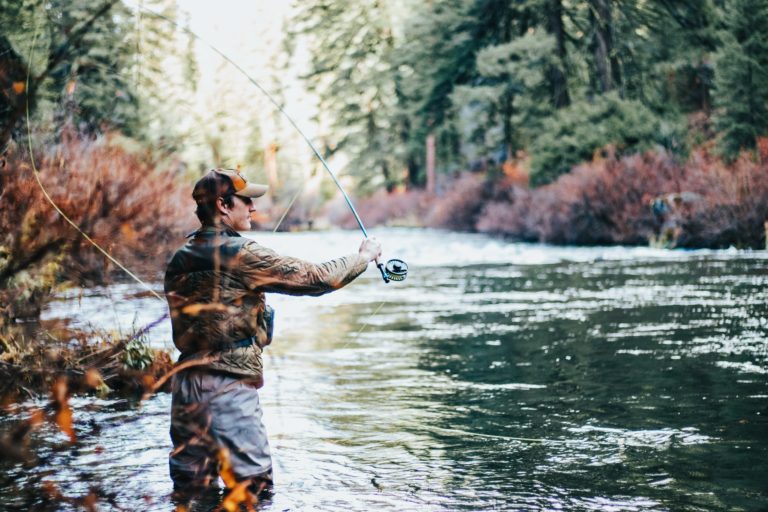
What is the Fly Line?
The fly line is a fishing line utilized by anglers to cast their artificial flies. Fly lines have been revolutionized since their original horsehair designs. Most fly lines are now modern-day plastic-coated lines.
There are numerous brands of fly lines that you can buy online. These can be adjusted for the specific game fish that you’re targeting and more.
What is the Fly Line Taper?
The fly line taper is often confusing. It is a small adjustment that is made by the manufacturer. The adjustments are there to make parts of the line thicker in spots, heavier in others and so on.
These little adjustments allow anglers better control of the line. In theory, anglers can then improve casting which can help to increase the chance of making a catch.
The fly line taper can improve the accuracy of angler casts.
The Types of Fly Line Taper
There are numerous types of fly line tapers that you need to understand to make sure that you get the right ones for your game fishing. This is not an exhaustive list. Numerous new types are being developed all the time. Some of these tapers are designed for specific game fish. Others are there for specific styles of fly fishing.
As the majority of fly fishing is for trout, panfish and bass, these are the main fly line tapers that need to be concerned.
The Weight-Forward Taper
The ‘standard’ taper for those trout fishing, the weight-forward, otherwise known as WF, is a fly line that has more weight and thickness on the first 10 yards of the fly line. The rest of the line is uniform and meets the standards of typical fly lines.
The main aim of the weight-forward taper is to provide additional weight to the fly line. This makes casting much easier for the fisherman, especially when the weather is windy. The position of the weight also means that casting a line can be done further than with other options.
A final advantage of the Weight-Forward taper is that it allows for larger flies to land properly and be more alluring to the target fish. Therefore, the proper presentation will increase the chances of catching the fish.
The Double Taper
The double taper, also known as DT, is a trout fly line. It is perfect for the game fish unless you’re looking to cast a long line or it is particularly windy on the day.
The design of the double taper is that the first fifteen feet of the fly line gradually widens. The next sixty or so feet of the line are a constant weight and width. The final 15 feet of the line will become less wide again and reduce in weight.
One of the biggest advantages of this fly line is that the fly line can be reversed as both ends are the same. The design of the double taper allows for anglers to have a lighter touch when they are casting and presenting the fly. But this is not possible when there are strong or mild winds. Nor are shorter casts possible.
The Level Taper
The Level Taper, also known as the L taper, is the easiest of the fly line tapers to grasp. This is because it actually has no taper. It is the same width and weight along the entire length of the fly line.
This line might seem like it would be a great option for any angler looking to fly fish. The line does float nicely due to the even distribution of weight. And the fly line is also one of the least expensive that is available for anglers.
However, these are small advantages when you are comparing them to the disadvantages. The level taper fly lines are known to be harder to control than either the double taper or the weight-forward taper. The level taper fly lines are also known to slap into the water. This can scare game fish away and therefore no fish are caught.
Therefore, it is highly recommended to not use the level taper unless it is absolutely necessary. Those who are new to fly fishing should not use this type of taper.
The Shooting-Taper
The Shooting Taper, also known as the ST, is very similar to the weight-forward fly line. The first 20 feet of the line is very heavily weighted, even more so than you would find on the weight-forward. The remaining part of the line is uniform, but it is more narrow.
The purpose of the shooting-taper is for tournament casting. This is where anglers try to cast the fly as far from them as possible. There are very few anglers who are going to use this type of line because the hassles of the line outweigh the long casting benefits.
Unless you are an expert angler, this type of line is probably not going to be useful.
Understanding Fly Line Density
Understanding the fly line density is a really simple concept. It is basically whether or not the fly line will float, sink or partially sink.
The floating fly line is one of the most popular and versatile fly lines that is used. The line floats, as the name suggests unless you weigh down the line. Most anglers realize that if they can own just one fly line, then it is by far the best to own a floating fly line.
The sinking fly line sinks, as the name suggests. There are different rates at which the line may sink. This is known as the sink rate. Some can sink very fast, but others are slower. These rates are steady, however, so they won’t look unnatural.
If you’re looking at purchasing a fly line, you can find the sink rate of the line by looking at the box. This is normally measured at a rate known as fps or feet per second.
Sinking fly lines are one of the best for big water fishing, especially for those who are fishing on lakes and saltwater. When fishing in rivers and streams, this type of fly line has no advantage and should not be used in these conditions.
The sinking fly lines are not very good for those who are looking for fly line for trout. However, there is a hybrid that is known as the sink-tip fly line. The sink-tip fly line has only the first 10-30 feet of the link sinking. The remainder of the line will float. The idea is that it allows for the fishing of nymphs and streamers in moderately fast river currents.
For those who are starting, you will want to get the floating fly line. When you’ve got more experience, you can then buy another type of line.
Fly Line Color
The fly line color is very important when it comes to fly fishing. The first thing to remember, and the first myth to dispel, is that on bright days and even on any daylight fishing, the fly line can’t blend into the environment. Any game fish will be able to see the line, especially from the bottom of the river, lake, etc.
From the perspective of the game fish, the unnatural line is something to be wary of. This makes it very unlikely to go for any bait that is there.
Therefore, it is important to note that the color of the fly line during general daylight will not matter. The fish will generally see something that is scary and it will take time to entice them to take the bait.
Therefore, when you are choosing your fly line, you can choose a color that is best for your sight. This could be anything from green to pink. It might also depend on the current weather conditions to what color you can see best.
During low light conditions, the color can be more important. Pure black is not the best color as this is very unnatural. Instead, you might want to choose a line that is dark brown or gray. This will largely depend on the color or clarity of the water.
The Best Fly Line Available
Here are some of the best fly lines that are available for you to purchase and use.
Piscifun Sword Fly Fishing Line
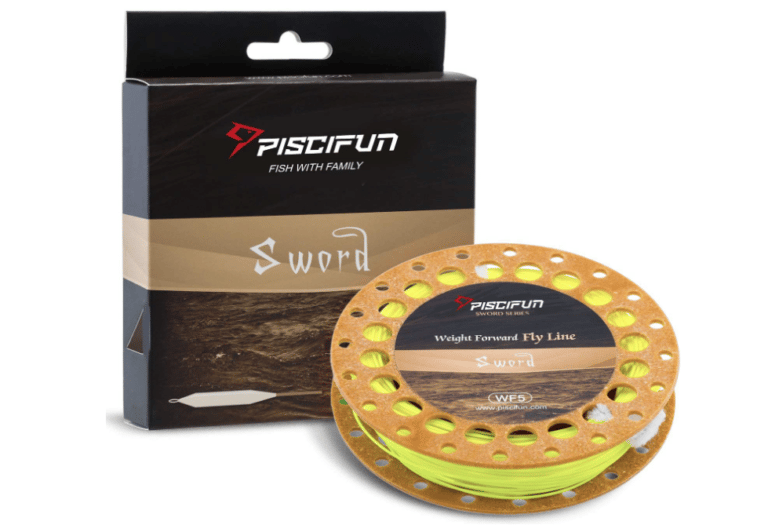
When it comes to a fly line, few are as good as this one for those who are both beginners and experts. It is a well-designed line that is highly versatile, perfect for catching trout in numerous conditions. The longer head and bigger diameter make this line easier for the angler to cast.
The braided core is perfect for any weather condition and the integrated slickness is integrated throughout the PVC layer and allows for maximum distance, performance and durability.
The sleek and enhanced welded loop makes the attachment quick and easy. The welded loop also means that the line can be used again and again. The line can transfer energy better and allows for the turnover to be better.
Highlights:
- 100-foot fly fishing line.
- Floating fly line that is perfect for beginners and experts.
- Comes in several sizes.
- Perfect for trout and other large river fish.
ANGLER DREAM Gold Fly Line 90FT
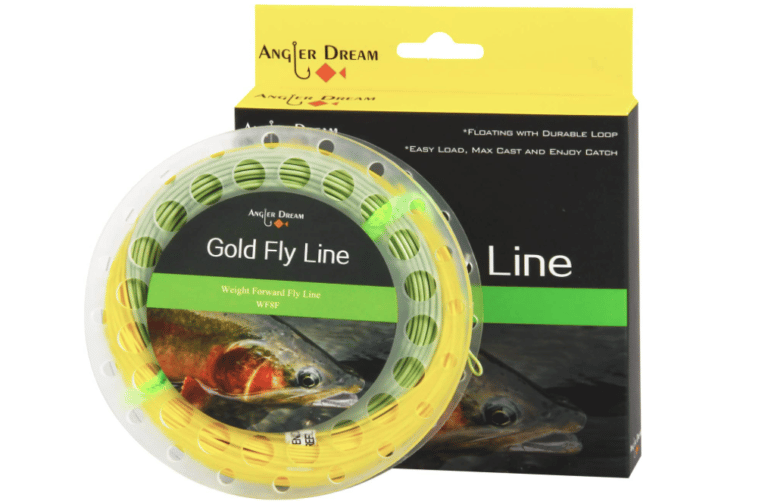
This is the ultimate all-around fly line that is designed for beginners and experts alike. The weight-forward line is perfect as the front of the line is likely to sink to the bottom of the stream/river.
The special taper design is perfect for loop stability at a long distance. There is a long-distance casting that can be very accurate. And there is a unique profile that allows a road to load at a closer range. The line also allows for the perfect presentation of the flies between any size of 22 and 2.
This line has a bright color, allowing any angler to see the line regardless of the conditions of the water. It is the perfect line to use during the day, but not a great night-fishing line. However, the line is perfectly protected from numerous weather conditions and regular use. The fly line also included two welded loops, therefore you can connect the fly backing and fly leader in a more promising strength.
Highlights:
- Bright orange color, perfect for seeing in the stream.
- Perfect for daylight fly fishing.
- Strong and robust, can be used numerous times.
- Designed for beginners and experts alike.
AnglerDream WF Fly Fishing Line Kit 1 2 3 4 5 6 7 8 9WT
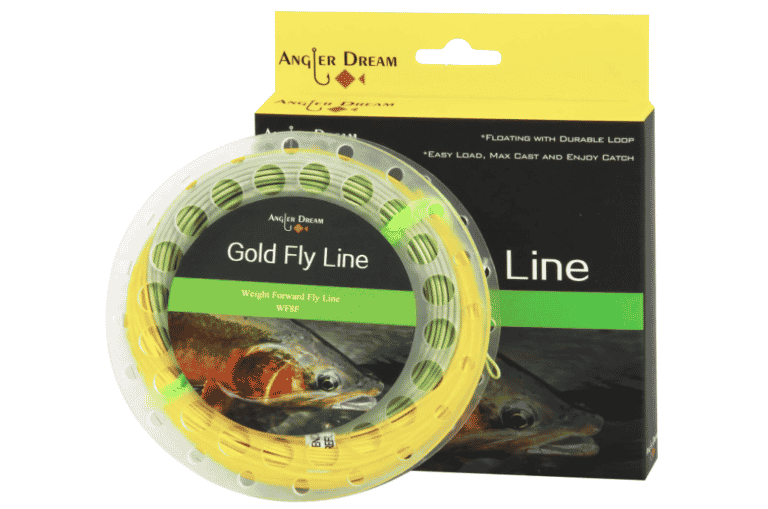
This is a weight-forward line that is perfect for trout fishing and great for beginners/experts. The line allows for a consistent, precise and accurate cast under any condition. The line can extend to 50 yards and has a low coefficient of friction allowing you to cast your line with minimal wear and tear on your guides. The braided line is also perfect for tiring out a speedy fish, providing you with ample time to catch it.
The nylon leaders are great for casting dry flies, streamers or an indicator with a weighted nymph, even when you’re fishing in the most challenging of conditions.
Highlights:
- Durable fly fishing line.
- A weight-forward line that is perfect for beginners.
- Can be used with numerous lures.
Can extend to fifty yards.
HERCULES Fly Fishing Line Floating Weight Forward
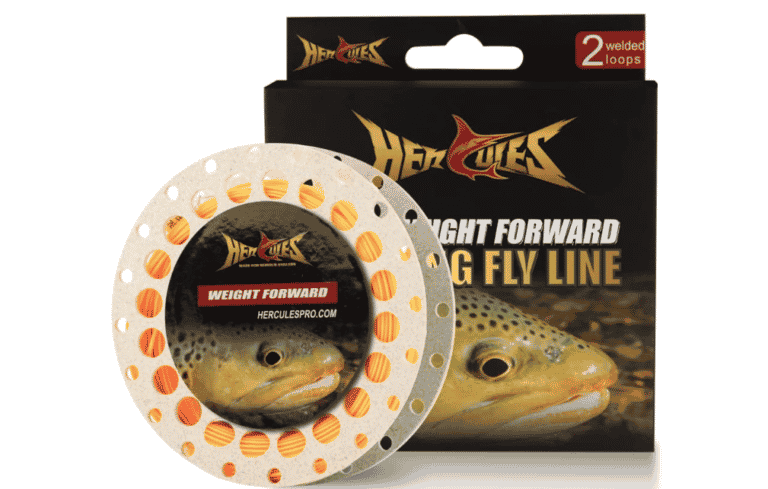
This is a fantastic budget fly fishing line whether you’re a beginner or an expert. This weight-forward line is perfect for accurate casts and easy to lift from the water’s surface. The double welded loops on both the front and back make attaching the backing and leaders simple and quick.
Even in windy conditions, the presentation available from the Hercules fly fishing floating weight is great. This is thanks to the supple memory-free braided multifilament core.
Highlights:
- Perfect for the beginner and expert fisherman.
- Ideal for fishing in streams and open water.
- Comes in numerous styles.
- A budget option.
M MAXIMUMCATCH Maxcatch
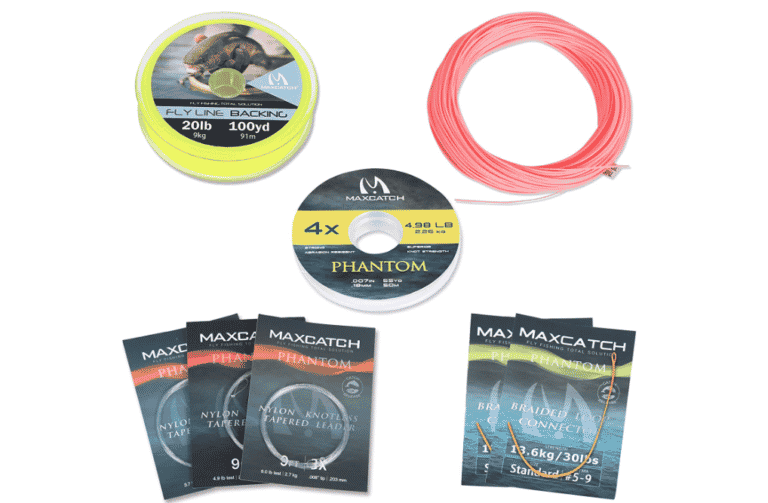
This is another budget option when you’re looking to buy an effective fly line. This is a weight-forward, floating option that is easy for beginners but also suits the needs of expert anglers. The line offers accuracy at any distance, even if you’re new.
The PVC coating outside of the braided line allows for the line to float. The line will also be very durable, allowing it to be used in numerous weather conditions and also be used numerous times.
The long head design allows for better line management. This can help to efficiently transfer more energy to the leader on the line.
Highlights:
- Perfect fly fishing line for new and experienced anglers.
- Can be used numerous times.
- Suitable for bad weather conditions.
- Floating line.
SF Fly Fishing Floating Line with Welded Loop
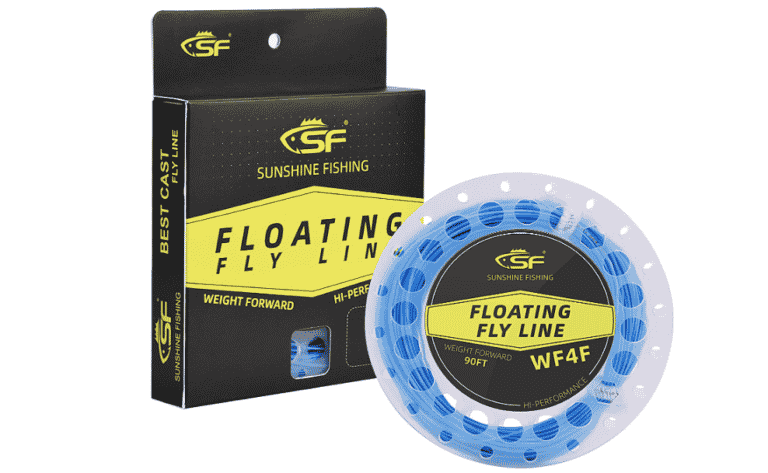
This 90-foot weight-forward line is an excellent choice for many. It is fluorescent yellow, allowing for easy-to-see lines in the water, regardless of the weather conditions. There is also the welding label, and welding rings. This makes it easier for you to replace the leaders. And there is a handy label that allows you to never confuse the weld ring to the other end.
The easy float attribute with the special taper design allows for accurate casting in any weather condition. Even on very windy days, you will be able to target the line to exactly where you want your line to go.
The material to make this fly fishing line is some of the best quality available. Therefore, the line is very durable and able to withstand lots of use.
Highlights:
- A great color scheme that allows for line visibility.
- Sturdy materials, allowing for longer use.
- A generous 90-foot length.
- Designed to make it easier to use and store.
Ashconfish Braided Fishing Line
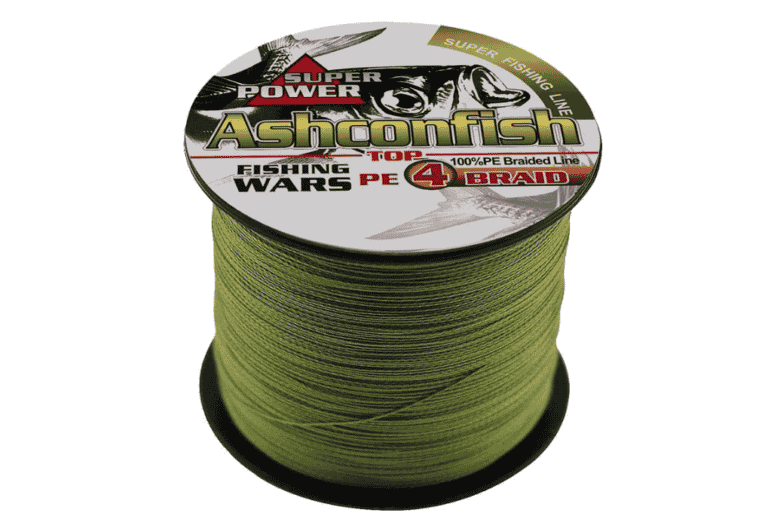
This fishing line is one of the most versatile. Available in numerous colors and with an ultra-high molecular weight polyethylene fiber that makes it strong and more robust. The color options allow you to have a fishing line that is suitable for day and night. Some bright color options are perfect for daylight fishing. Some of the darker options, like the army green color, are the perfect option for those who like to fish at night.
The advanced braid fishing wire is constructed to allow for high sensitivity that does not stretch. Yet the line can detect the lightest of bites. But the line is strong, allowing for strong knots to be tied into the line should you need to. The thread also has superior abrasion resistance.
To keep your line in good condition, the color has fade protection. Therefore, you’ll be able to see the line for longer. The line can also be used in freshwater and saltwater.
Highlights:
- Perfect for saltwater and freshwater.
- The line is strong, durable and flexible.
- Perfect for multiple uses.
- Comes in numerous colors, suitable for both day and night fishing.
RIO Dacron Fly Line Backing 20 lbs

This is an excellent fly line where there are several different line lengths to choose from. You can have lines that are just 100 yards long or you can choose spools of up to 5000 yards. Numerous color options are available for you.
The line is easier to knot than other options available on the market.
This strong line can be used numerous times and has a low stretch.
Highlights:
- Comes in numerous colors and lengths.
- Easier to tie knots in the line.
- Strong line.
- Can be used multiple times without damage.
Rio Premier Gold Fly Line
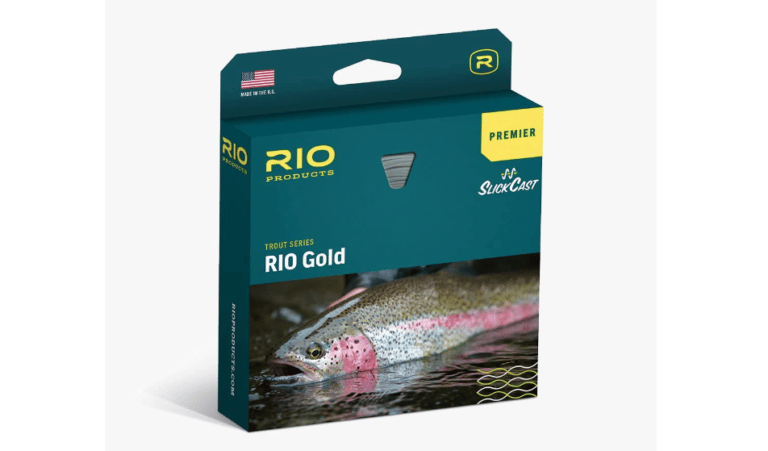
Rio Gold fly line is designed for the discriminating angler who demands the very best in performance and value. The Premier Gold incorporates all of the features that have made Rio’s world-renowned lines the choice of serious fly fishers around the globe.
Highlights:
- Long head and back taper that gives casters total line control and stability at range
- Different sizes and colors
- RIO’s MaxFloat tip technology
FAQs
There are numerous questions that you might have about fly lines. Here are some of the top questions along with their answers.
What makes the best fly line?
There are many factors to consider when choosing a fly line, including the type of fishing you plan to do, the weight and action of your rod, and personal preferences. But there are a few key characteristics that all great fly lines share.
First, the best fly line should be durable. It should be able to withstand being dragged through trees and over rocks and repeated use without losing its shape or performance.
Second, the best fly line should be easy to cast. It should have enough weight to carry your flies where you want them to go, but not so much that it is difficult to control. The best fly line is also designed to minimize friction, making for smoother casts and better overall performance.
What is the Running Line in fly fishing?
Running Line is an important part of the fly fishing line. It is the section of the fly fishing line that is attached to the backing and runs through the guides to the tip of the rod.
The running line is what propels the fly through the air and into the water. There are many different types of running lines on the market, and each has its own unique characteristics.
When choosing a running line for your fly fishing setup, it is important to consider the type of fish you are targeting and the type of water you will be fishing in. For example, if you are going to be fishing for trout in a river, you will need a different type of running line than if you were targeting bass in a lake.
There are two main types of running lines: floating and sinking. Floating running lines are best for fishing in rivers and streams while sinking running lines are better suited for lakes and ponds.
Floating running lines are made from materials that float on the surface of the water, such as nylon or polypropylene. They are ideal for fishing with dry flies, nymphs, and streamers.
Sinking running lines are made from materials that sink below the surface of the water, such as PVC or fluorocarbon. They are best for fishing with wet flies, nymphs, and streamers.
When choosing a floating or sinking running line, it is important to consider the weight and diameter of the line. Heavier lines are better for casting larger flies, while lighter lines are better for casting smaller flies.
The diameter of the running line also affects the casting performance. Thicker lines are easier to cast but can be more difficult to manage, while thinner lines are more difficult to cast but offer better control and accuracy.
What is fly line backing?
This is a line that extends the total length of the line on the fly fishing reel. The line is usually made from Dracon. Backing spools come in lengths that can range from 50 yards to 1000 yards. Though some can be longer. You attach the backing line to your fly reel arbor and fly line.
How long does a fly line last?
The length of time before you need to replace a fly line depends on several factors. Those needing replacing longer are often used in bad weather conditions or where there is a lot of debris in the river. The quality of the fly line also determines when it needs to be replaced.
How do you determine fly line weight?
Several factors should determine the fly line weight for your fishing expedition. However, one thing that you should consider is the strength of your rod. Your line should not be heavier than the rod can handle.
What color line is best for fly fishing?
There are numerous colors available for fly fishing lines. It is important to note that in daylight, no line will be hidden. It is important to be able to see the line. In contrast, those fishing at night should be using a darker coloured line that can be hidden from the fish.
Final Word
Above is all you need to know about fly fishing lines with some hints at which are the best on the market for you. All of these are of the highest quality and perfect for multiple trips. Fly fishing is great fun and trout is an excellent game fish, so starting with fly fishing is an excellent choice.
Fly line glossary
AFTMA: Association of Fishing Tackle Manufacturers and Merchants. This is an organization that rates fly lines according to their grain weight. The AFTMA system goes from 1-16, with 1 being the lightest and 16 being the heaviest.
Bevel: The bevel is the cutting edge of the hook. It can be either concave or convex in shape.
Bite: When a fish takes your fly, it is said to take a “bite” out of the fly line.
Braided line: Braided line is made up of multiple strands of material that are braided together. This type of line is robust and durable but can be more challenging to manage than other types of line.
Butt: The butt is the thickest part of the fly line. It is designed to help you cast heavier flies and sinking lines.
Concave: A concave shape has a depression in the middle. This type of shape is often found on hook points and blades.
Convex: A convex shape has a raised area in the middle. This type of shape is often found on fish scales and insect exoskeletons.
Cutting point: The cutting point is the sharpest part of the hook. It is used to puncture the flesh of the fish when you set the hook.
Double taper (DT): A double taper fly line has two different diameters along its length. The thicker part is in the middle, and the thinner portion is at the ends. This line is easy to manage and cast but can be more challenging to control in windy conditions.
Flipper: A flipper is a small piece of material attached to the back of the hook. It helps keep the fly line from tangling around the hook when casting.
Grain: The grain is a unit of measure for fly lines. It corresponds to the weight of the fly line in ounces. For example, a 5-grain fly line would weigh 5 ounces.
Leader: The leader is a length of monofilament or fluorocarbon attached to the end of the fly line. It is used to help keep the fly line from tangling around the hook when casting.
Monofilament: Monofilament is a single strand of material used to make a fishing line. It is solid and durable but more challenging to manage than other types of lines.
Point: The point is the sharpest part of the hook. It is used to puncture the flesh of the fish when you set the hook.
Sinker: A sinker is a small weight attached to the end of the fly line. It helps keep the fly line from tangling around the hook when casting.
Taper: The taper is the gradual change in diameter from the thickest part of the fly line to the thinnest. This taper helps the fly line to cast more smoothly and with less resistance.
Turnover: The turnover is the point at which the fly line changes direction when casting. This point is typically at the end of the forward cast, just before the backcast.
Wash: When a fish takes your fly, it is said to “wash” the fly line. This term is often used when describing how a fish reacts to a poorly-presented fly.




